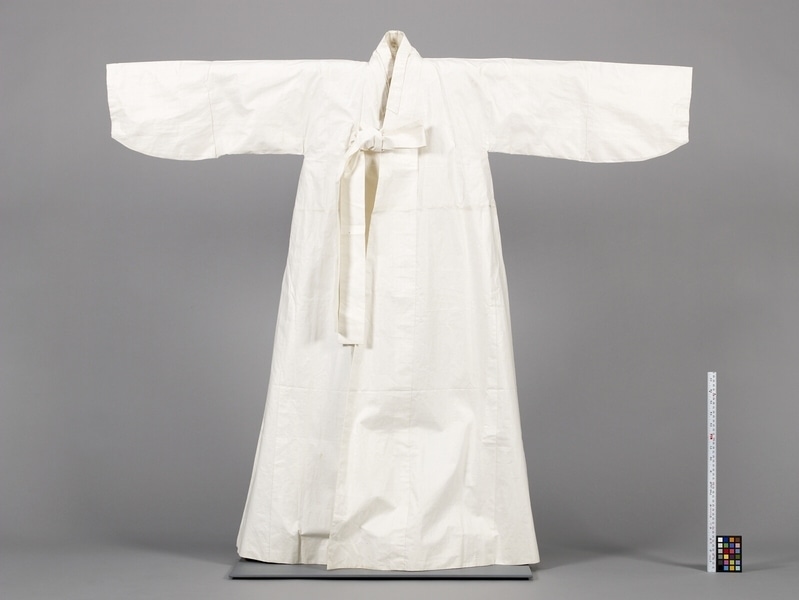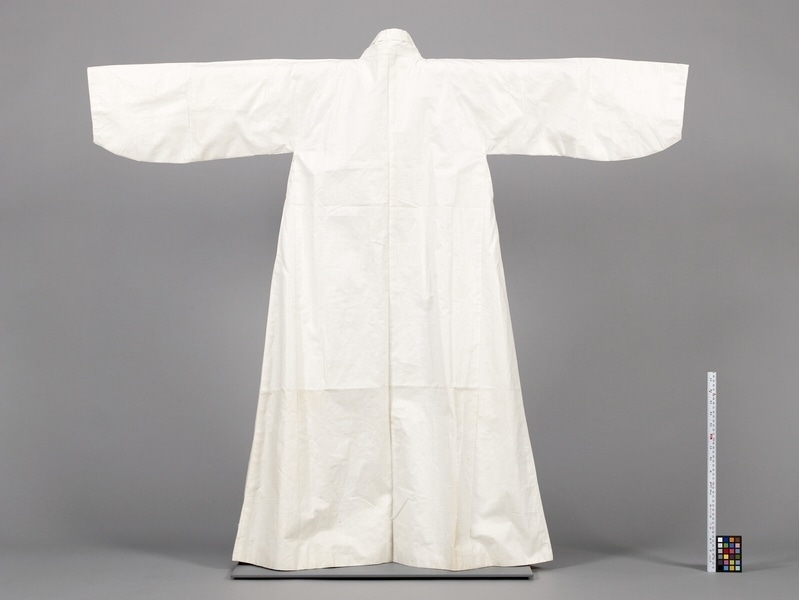Coat Item Number: 984/5 from the MOA: University of British Columbia


Description
Long coat with both the outer layer and lining made of fine white cotton fabric. The coat is made of ten flared vertical panels. It overlaps to the right, with two long, wide ribbons of the same fabric for ties. The coat is secured on the inside with shorter, narrow ties of the same material, positioned at the same level. When closed, the overlap forms a V neck edged with a stiff collar covered with shiny white fabric patterned with characters. The ribbon ties are centred at the lower ends of inner and outer facings with rounded edges. The sleeves are attached with a vertical seam somewhat beyond the shoulder and have a lower seam shaped in a convex curve, narrowing to the wrist. There is a small underarm reinforcement on each side, with an additional rectangular reinforcement or repair in the left underarm. At waist level there are openings at each side. All seams are concealed.
History Of Use
Such coats were worn by rural intellectuals, such as teachers, in the 1950s. Medium-weight lined coats were for spring and fall wear. The sleeves of the coat “Doo-ru-ma-gui” were less rounded than those of the jacket, “Jo-go-ri, worn underneath. The side slits gave the wearer access to objects attached to clothing worn underneath. Collars could be made at home if the wearer wanted them to be special, or they could be bought in markets. Fabric was very precious then, so repairs were made and reinforcements used.
Specific Techniques
Facings were ironed, pasted, and sewn in place. Hem and ribbons were hand-sewn, and hand-sewn in place. All seams are concealed, which was achieved by sewing the garment inside-out, and then reversing it.
Narrative
Very traditional skill was used to attach the inner facing.
Iconographic Meaning
Coats of this fine white material signified that the wearers were intellectuals.
Item History
- Made in Korea during 1955
- Owned by Hi Soon Kim before August 7, 1984
- Received from Hi Soon Kim (Seller) and Unknown (Funding source) on August 7, 1984
What
- Name
- Coat
- Identification Number
- 984/5
- Type of Item
- coat
- Material
- cotton fibre, rayon fibre, paper and paste adhesive
- Manufacturing Technique
- spun, woven, cut, sewn and pasted
- Overall
- height 124.0 cm, width 138.5 cm
Who
- Culture
- Korean
- Previous Owner
- Hi Soon Kim
- Received from
- Hi Soon Kim (Seller) and Unknown (Funding source)
Where
- Holding Institution
- MOA: University of British Columbia
- Made in
- Korea
When
- Creation Date
- during 1955
- Ownership Date
- before August 7, 1984
- Acquisition Date
- on August 7, 1984
Other
- Item Classes
- textiles
- Condition
- good
- Accession Number
- 0984/0005